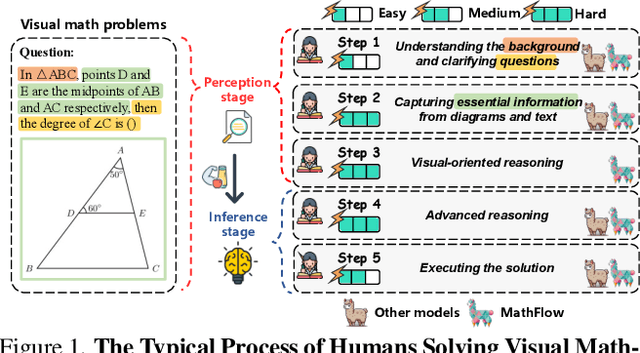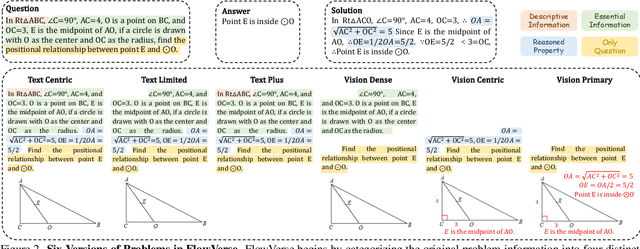Hangjie Yuan
OptMark: Robust Multi-bit Diffusion Watermarking via Inference Time Optimization
Aug 29, 2025Abstract:Watermarking diffusion-generated images is crucial for copyright protection and user tracking. However, current diffusion watermarking methods face significant limitations: zero-bit watermarking systems lack the capacity for large-scale user tracking, while multi-bit methods are highly sensitive to certain image transformations or generative attacks, resulting in a lack of comprehensive robustness. In this paper, we propose OptMark, an optimization-based approach that embeds a robust multi-bit watermark into the intermediate latents of the diffusion denoising process. OptMark strategically inserts a structural watermark early to resist generative attacks and a detail watermark late to withstand image transformations, with tailored regularization terms to preserve image quality and ensure imperceptibility. To address the challenge of memory consumption growing linearly with the number of denoising steps during optimization, OptMark incorporates adjoint gradient methods, reducing memory usage from O(N) to O(1). Experimental results demonstrate that OptMark achieves invisible multi-bit watermarking while ensuring robust resilience against valuemetric transformations, geometric transformations, editing, and regeneration attacks.
C-Flat++: Towards a More Efficient and Powerful Framework for Continual Learning
Aug 26, 2025Abstract:Balancing sensitivity to new tasks and stability for retaining past knowledge is crucial in continual learning (CL). Recently, sharpness-aware minimization has proven effective in transfer learning and has also been adopted in continual learning (CL) to improve memory retention and learning efficiency. However, relying on zeroth-order sharpness alone may favor sharper minima over flatter ones in certain settings, leading to less robust and potentially suboptimal solutions. In this paper, we propose \textbf{C}ontinual \textbf{Flat}ness (\textbf{C-Flat}), a method that promotes flatter loss landscapes tailored for CL. C-Flat offers plug-and-play compatibility, enabling easy integration with minimal modifications to the code pipeline. Besides, we present a general framework that integrates C-Flat into all major CL paradigms and conduct comprehensive comparisons with loss-minima optimizers and flat-minima-based CL methods. Our results show that C-Flat consistently improves performance across a wide range of settings. In addition, we introduce C-Flat++, an efficient yet effective framework that leverages selective flatness-driven promotion, significantly reducing the update cost required by C-Flat. Extensive experiments across multiple CL methods, datasets, and scenarios demonstrate the effectiveness and efficiency of our proposed approaches. Code is available at https://github.com/WanNaa/C-Flat.
DFVEdit: Conditional Delta Flow Vector for Zero-shot Video Editing
Jun 26, 2025Abstract:The advent of Video Diffusion Transformers (Video DiTs) marks a milestone in video generation. However, directly applying existing video editing methods to Video DiTs often incurs substantial computational overhead, due to resource-intensive attention modification or finetuning. To alleviate this problem, we present DFVEdit, an efficient zero-shot video editing method tailored for Video DiTs. DFVEdit eliminates the need for both attention modification and fine-tuning by directly operating on clean latents via flow transformation. To be more specific, we observe that editing and sampling can be unified under the continuous flow perspective. Building upon this foundation, we propose the Conditional Delta Flow Vector (CDFV) -- a theoretically unbiased estimation of DFV -- and integrate Implicit Cross Attention (ICA) guidance as well as Embedding Reinforcement (ER) to further enhance editing quality. DFVEdit excels in practical efficiency, offering at least 20x inference speed-up and 85\% memory reduction on Video DiTs compared to attention-engineering-based editing methods. Extensive quantitative and qualitative experiments demonstrate that DFVEdit can be seamlessly applied to popular Video DiTs (e.g., CogVideoX and Wan2.1), attaining state-of-the-art performance on structural fidelity, spatial-temporal consistency, and editing quality.
WorldVLA: Towards Autoregressive Action World Model
Jun 26, 2025Abstract:We present WorldVLA, an autoregressive action world model that unifies action and image understanding and generation. Our WorldVLA intergrates Vision-Language-Action (VLA) model and world model in one single framework. The world model predicts future images by leveraging both action and image understanding, with the purpose of learning the underlying physics of the environment to improve action generation. Meanwhile, the action model generates the subsequent actions based on image observations, aiding in visual understanding and in turn helps visual generation of the world model. We demonstrate that WorldVLA outperforms standalone action and world models, highlighting the mutual enhancement between the world model and the action model. In addition, we find that the performance of the action model deteriorates when generating sequences of actions in an autoregressive manner. This phenomenon can be attributed to the model's limited generalization capability for action prediction, leading to the propagation of errors from earlier actions to subsequent ones. To address this issue, we propose an attention mask strategy that selectively masks prior actions during the generation of the current action, which shows significant performance improvement in the action chunk generation task.
VideoMAR: Autoregressive Video Generatio with Continuous Tokens
Jun 18, 2025Abstract:Masked-based autoregressive models have demonstrated promising image generation capability in continuous space. However, their potential for video generation remains under-explored. In this paper, we propose \textbf{VideoMAR}, a concise and efficient decoder-only autoregressive image-to-video model with continuous tokens, composing temporal frame-by-frame and spatial masked generation. We first identify temporal causality and spatial bi-directionality as the first principle of video AR models, and propose the next-frame diffusion loss for the integration of mask and video generation. Besides, the huge cost and difficulty of long sequence autoregressive modeling is a basic but crucial issue. To this end, we propose the temporal short-to-long curriculum learning and spatial progressive resolution training, and employ progressive temperature strategy at inference time to mitigate the accumulation error. Furthermore, VideoMAR replicates several unique capacities of language models to video generation. It inherently bears high efficiency due to simultaneous temporal-wise KV cache and spatial-wise parallel generation, and presents the capacity of spatial and temporal extrapolation via 3D rotary embeddings. On the VBench-I2V benchmark, VideoMAR surpasses the previous state-of-the-art (Cosmos I2V) while requiring significantly fewer parameters ($9.3\%$), training data ($0.5\%$), and GPU resources ($0.2\%$).
Branch, or Layer? Zeroth-Order Optimization for Continual Learning of Vision-Language Models
Jun 14, 2025Abstract:Continual learning in vision-language models (VLMs) faces critical challenges in balancing parameter efficiency, memory consumption, and optimization stability. While First-Order (FO) optimization (e.g., SGD) dominate current approaches, their deterministic gradients often trap models in suboptimal local minima and incur substantial memory overhead. This paper pioneers a systematic exploration of Zeroth-Order (ZO) optimization for vision-language continual learning (VLCL). We first identify the incompatibility of naive full-ZO adoption in VLCL due to modality-specific instability. To resolve this, we selectively applying ZO to either vision or language modalities while retaining FO in the complementary branch. Furthermore, we develop a layer-wise optimization paradigm that interleaves ZO and FO across network layers, capitalizing on the heterogeneous learning dynamics of shallow versus deep representations. A key theoretical insight reveals that ZO perturbations in vision branches exhibit higher variance than language counterparts, prompting a gradient sign normalization mechanism with modality-specific perturbation constraints. Extensive experiments on four benchmarks demonstrate that our method achieves state-of-the-art performance, reducing memory consumption by 89.1% compared to baselines. Code will be available upon publication.
Adapt before Continual Learning
Jun 05, 2025Abstract:Continual Learning (CL) seeks to enable neural networks to incrementally acquire new knowledge (plasticity) while retaining existing knowledge (stability). While pre-trained models (PTMs) have become pivotal in CL, prevailing approaches freeze the PTM backbone to preserve stability, limiting their plasticity, particularly when encountering significant domain gaps in incremental tasks. Conversely, sequentially finetuning the entire PTM risks catastrophic forgetting of generalizable knowledge, exposing a critical stability-plasticity trade-off. To address this challenge, we propose Adapting PTMs before the core CL process (ACL), a novel framework that refines the PTM backbone through a plug-and-play adaptation phase before learning each new task with existing CL approaches (e.g., prompt tuning). ACL enhances plasticity by aligning embeddings with their original class prototypes while distancing them from others, theoretically and empirically shown to balance stability and plasticity. Extensive experiments demonstrate that ACL significantly improves CL performance across benchmarks and integrated methods, offering a versatile solution for PTM-based CL. Code is available at https://github.com/byyx666/ACL_code.
Rethinking the Stability-Plasticity Trade-off in Continual Learning from an Architectural Perspective
Jun 05, 2025Abstract:The quest for Continual Learning (CL) seeks to empower neural networks with the ability to learn and adapt incrementally. Central to this pursuit is addressing the stability-plasticity dilemma, which involves striking a balance between two conflicting objectives: preserving previously learned knowledge and acquiring new knowledge. While numerous CL methods aim to achieve this trade-off, they often overlook the impact of network architecture on stability and plasticity, restricting the trade-off to the parameter level. In this paper, we delve into the conflict between stability and plasticity at the architectural level. We reveal that under an equal parameter constraint, deeper networks exhibit better plasticity, while wider networks are characterized by superior stability. To address this architectural-level dilemma, we introduce a novel framework denoted Dual-Arch, which serves as a plug-in component for CL. This framework leverages the complementary strengths of two distinct and independent networks: one dedicated to plasticity and the other to stability. Each network is designed with a specialized and lightweight architecture, tailored to its respective objective. Extensive experiments demonstrate that Dual-Arch enhances the performance of existing CL methods while being up to 87% more compact in terms of parameters. Code: https://github.com/byyx666/Dual-Arch.
Taming Consistency Distillation for Accelerated Human Image Animation
Apr 15, 2025Abstract:Recent advancements in human image animation have been propelled by video diffusion models, yet their reliance on numerous iterative denoising steps results in high inference costs and slow speeds. An intuitive solution involves adopting consistency models, which serve as an effective acceleration paradigm through consistency distillation. However, simply employing this strategy in human image animation often leads to quality decline, including visual blurring, motion degradation, and facial distortion, particularly in dynamic regions. In this paper, we propose the DanceLCM approach complemented by several enhancements to improve visual quality and motion continuity at low-step regime: (1) segmented consistency distillation with an auxiliary light-weight head to incorporate supervision from real video latents, mitigating cumulative errors resulting from single full-trajectory generation; (2) a motion-focused loss to centre on motion regions, and explicit injection of facial fidelity features to improve face authenticity. Extensive qualitative and quantitative experiments demonstrate that DanceLCM achieves results comparable to state-of-the-art video diffusion models with a mere 2-4 inference steps, significantly reducing the inference burden without compromising video quality. The code and models will be made publicly available.
MathFlow: Enhancing the Perceptual Flow of MLLMs for Visual Mathematical Problems
Mar 19, 2025



Abstract:Despite impressive performance across diverse tasks, Multimodal Large Language Models (MLLMs) have yet to fully demonstrate their potential in visual mathematical problem-solving, particularly in accurately perceiving and interpreting diagrams. Inspired by typical processes of humans, we hypothesize that the perception capabilities to extract meaningful information from diagrams is crucial, as it directly impacts subsequent inference processes. To validate this hypothesis, we developed FlowVerse, a comprehensive benchmark that categorizes all information used during problem-solving into four components, which are then combined into six problem versions for evaluation. Our preliminary results on FlowVerse reveal that existing MLLMs exhibit substantial limitations when extracting essential information and reasoned property from diagrams and performing complex reasoning based on these visual inputs. In response, we introduce MathFlow, a modular problem-solving pipeline that decouples perception and inference into distinct stages, thereby optimizing each independently. Given the perceptual limitations observed in current MLLMs, we trained MathFlow-P-7B as a dedicated perception model. Experimental results indicate that MathFlow-P-7B yields substantial performance gains when integrated with various closed-source and open-source inference models. This demonstrates the effectiveness of the MathFlow pipeline and its compatibility to diverse inference frameworks. The FlowVerse benchmark and code are available at https://github.com/MathFlow-zju/MathFlow.
 Add to Chrome
Add to Chrome Add to Firefox
Add to Firefox Add to Edge
Add to Edge